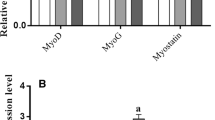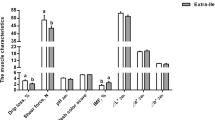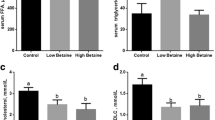Abstract
Branched-chain amino acids (BCAA), including leucine (Leu), isoleucine (Ile), and valine (Val), play critical roles in energy homeostasis and lipid metabolism in addition to their other functions, such as in protein metabolism. This study investigated the effects of different dietary BCAA ratios on the intramuscular fat (IMF) content and fatty acid composition in different location of skeletal muscles, including the longissimus dorsi (LD), biceps femoris (BF), and psoas major (PM) muscles of growing pigs, and also examined the mRNA expression levels of genes involved in lipid metabolism in these muscle tissues. The experiment was performed on 40 growing pigs (Large White × Landrace) with a similar initial weight (9.85 ± 0.35 kg). The pigs were randomly assigned to one of five diets: diet A was a positive control and contained 20 % crude protein (CP) with a Leu:Ile:Val ratio of 1:0.51:0.63 according to the recommendation of the National Research Council (NRC); for diets B to E, the CP level was reduced to 17 %, and the Leu:Ile:Val ratios were 1:1:1, 1:0.75:0.75, 1:0.51:0.63, and 1:0.25:0.25, respectively. No significant difference was observed in the average feed intake and feed efficiency of the pigs fed the low protein diet (17 % CP) with BCAA treatments relative to the positive control. However, there was a tendency for increased feed efficiency of the 1:0.75:0.75 group compared with the 1:1:1 group (P = 0.09). The BCAA ratio of 1:0.75:0.75 (17 % CP) increased the IMF content of BF muscle (P < 0.01). Moreover, varied dietary BCAA supplementation with a reduced protein level had different effects on the fatty acid composition of the LD, BF, and PM muscles. The BCAA ratio of 1:0.51:0.63–1:0.75:0.75 (17 % CP) significantly lowered the ratio of n-6 to n-3 polyunsaturated fatty acid in these muscles compared with the positive control group (20 % CP). This effect was associated with an increase in mRNA expression levels of acetyl-CoA carboxylase, lipoprotein lipase, fatty acid transport protein, and fatty acid binding protein 4 in the muscles (P < 0.05). The results indicated that the reduced protein diet (17 % CP) with the BCAA ratio within 1:0.25:0.25–1:0.75:0.75 could increase the IMF content in BF muscle and significantly improve the fatty acid composition in different skeletal muscles accompanied by changes in the expression of genes involved in lipid metabolism, compared with those in the pigs that received adequate dietary protein (20 %), which might result in improved eating quality and nutritional value of the meat.

Similar content being viewed by others
Abbreviations
- ACC:
-
Acetyl-CoA carboxylase
- ADG:
-
Average daily gain
- ADFI:
-
Average daily feed intake
- BCAA:
-
Branched-chain amino acids
- BF:
-
Biceps femoris
- CHD:
-
Coronary heart disease
- CP:
-
Crude protein
- FABP4:
-
Fatty acid binding protein 4
- FATP-1:
-
Fatty acid transport protein
- HDL-C:
-
High density lipoprotein-cholesterol
- HSL:
-
Hormone-sensitive lipase
- Ile:
-
Isoleucine
- IMF:
-
Intramuscular fat
- LD:
-
Longissimus dorsi
- LDL-C:
-
Low density lipoprotein-cholesterol
- Leu:
-
Leucine
- LPL:
-
Lipoprotein lipase
- LPS:
-
Lipase
- M-CPT-1:
-
Muscle carnitine palmitoyltransferase 1
- MUFA:
-
Monounsaturated fatty acid
- NEFAs:
-
Nonesterified fatty acids
- NRC:
-
National Research Council
- PM:
-
Psoas major
- PUFA:
-
Polyunsaturated fatty acid
- SFA:
-
Saturated fatty acid
- TAG:
-
Triacylglycerol
- TC:
-
Total cholesterol
- Val:
-
Valine
References
Anderson JW, Konz EC (2001) Obesity and disease management: effects of weight loss on comorbid conditions. Obes Res 9:326s–334s
Arakawa M, Masaki T, Nishimura J et al (2011) The effects of branched-chain amino acid granules on the accumulation of tissue triglycerides and uncoupling proteins in diet-induced obese mice. Endocr J 58:161–170
Augustus AS, Kako Y, Yagyu H et al (2003) Routes of FA delivery to cardiac muscle: modulation of lipoprotein lipolysis alters uptake of TG-derived FA. Am J Physiol Endocrinol Metab 284:E331–E339
Bai J, Greene E, Li WF et al (2015) Branched-chain amino acids modulate the expression of hepatic fatty acid metabolism-related genes in female broiler chickens. Mol Nutr Food Res 59:1171–1181
Calder PC (2006) Branched-chain amino acids and immunity. J Nutr 136:288S–293S
Cheon W (2015) Effect of leucine uptake on hepatic and skeletal muscle gene expression in rats: a microarray analysis. J Exerc Nutrition Biochem 19:139–146
Contreas MA, Rapoport SI (2002) Recent studies on interactions between n-3 and n-6 polyunsaturated fatty acids in brain and other tissues. Curr Opin Lipidol 13:267–272
Daszkiewicz T, Bak T, Denaburski J (2005) Quality of pork with a different intramuscular fat (IMF) content. Pol J Food Nutr Sci 14:31–35
De Simone R, Vissicchio F, Mingarelli C et al (2013) Branched-chain amino acids influence the immune properties of microglial cells and their responsiveness to pro-inflammatory signals. Biochim Biophys Acta Mol Basis Dis 1832:650–659
De Smet S, Raes K, Demeyer D (2004) Meat fatty acid composition as affected by fatness and genetic factors: a review. Anim Res 53:81–98
DeVol DL, McKeith FK, Bechtel PJ et al (1988) Variations in composition and palatability traits and relationships between muscle: characteristics and palatability in a random sample of pork carcasses. J Anim Sci 66:385–395
DiRusso CC, Li H, Darwis D et al (2005) Comparative biochemical studies of the murine fatty acid transport proteins (FATP) expressed in yeast. J Biol Chem 280:16829–16837
Doege H, Stahl A (2006) Protein-mediated fatty acid uptake: novel insights from in vivo models. Physiology 21:259–268
Donato J Jr, Pedrosa RG, Cruzat VF et al (2006) Effects of leucine supplementation on the body composition and protein status of rats submitted to food restriction. Nutrition 22:520–527
Du Y, Meng QS, Zhang Q et al (2012) Isoleucine or valine deprivation stimulates fat loss via increasing energy expenditure and regulating lipid metabolism in WAT. Amino Acids 43:725–734
Duan YH, Li FN, Li LL et al (2014) n-6:n-3 PUFA ratio is involved in regulating lipid metabolism and inflammation in pigs. Br J Nutr 111:445–451
Duan YH, Li FN, Liu HN et al (2015) Nutritional and regulatory roles of leucine in muscle growth and fat reduction. Front Biosci Landmark 20:796–813
Goichon A, Chan P, Lecleire S et al (2013) An enteral leucine supply modulates human duodenal mucosal proteome and decreases the expression of enzymes involved in fatty acid beta-oxidation. J Proteomics 78:535–544
Hocquette JF, Graulet B, Olivecrona T (1998) Lipoprotein lipase activity and mRNA levels in bovine tissues. Comp Biochem Phys B 121:201–212
Hocquette JF, Gondret F, Baeza E et al (2010) Intramuscular fat content in meat-producing animals: development, genetic and nutritional control, and identification of putative markers. Animal 4:303–319
Hu FB, Stampfer MJ, Manson JE et al (1999) Dietary saturated fats and their food sources in relation to the risk of coronary heart disease in women. Am J Clin Nutr 70:1001–1008
Hyun Y, Ellis M, McKeith FK et al (2003) Effect of dietary leucine level on growth performance, and carcass and meat quality in finishing pigs. Can J Anim Sci 83:315–318
Hyun Y, Kim JD, Ellis M et al (2007) Effect of dietary leucine and lysine levels on intramuscular fat content in finishing pigs. Can J Anim Sci 87:303–306
Joshi MA, Jeoung NH, Obayashi M et al (2006) Impaired growth and neurological abnormalities in branched-chain alpha-keto acid dehydrogenase kinase-deficient mice. Biochem J 400:153–162
Koonen DPY, Glatz JFC, Bonen A et al (2005) Long-chain fatty acid uptake and FAT/CD36 translocation in heart and skeletal muscle. Bba Mol Cell Biol 1736:163–180
Li F, Yin Y, Tan B et al (2011) Leucine nutrition in animals and humans: mTOR signaling and beyond. Amino Acids 41:1185–1193
Li FN, Duan YH, Li YH et al (2015) Effects of dietary n-6:n-3 PUFA ratio on fatty acid composition, free amino acid profile and gene expression of transporters in finishing pigs. Br J Nutr 113:739–748
Liu Y, Li F, He L et al (2015) Dietary protein intake affects expression of genes for lipid metabolism in porcine skeletal muscle in a genotype-dependent manner. Br J Nutr 113:1069–1077
Liu Y, Kong X, Li F et al (2016) Co-dependence of genotype and dietary protein intake to affect expression on amino acid/peptide transporters in porcine skeletal muscle. Amino Acids 48:75–90
Lobo S, Wiczer BM, Smith AJ et al (2007) Fatty acid metabolism in adipocytes: functional analysis of fatty acid transport proteins 1 and 4. J Lipid Res 48:609–620
Madeira MS, Pires VM, Alfaia CM et al (2014) Combined effects of dietary arginine, leucine and protein levels on fatty acid composition and gene expression in the muscle and subcutaneous adipose tissue of crossbred pigs. Br J Nutr 111:1521–1535
National Research Council (2012) Nutrient requirements of swine, 11th edn. National Academic Press, Washington, DC
Perry D, Nicholls PJ, Thompson JM (1998) The effect of sire breed on the melting point and fatty acid composition of subcutaneous fat in steers. J Anim Sci 76:87–95
Rhee KS, Waldron DF, Ziprin YA et al (2000) Fatty acid composition of goat diets vs intramuscular fat. Meat Sci 54:313–318
Russo GL (2009) Dietary n-6 and n-3 polyunsaturated fatty acids: from biochemistry to clinical implications in cardiovascular prevention. Biochem Pharmacol 77:937–946
Schwenk RW, Holloway GP, Luiken JJ et al (2010) Fatty acid transport across the cell membrane: regulation by fatty acid transporters. Prostaglandins Leukot Essent Fatty Acids 82:149–154
Sebastian D, Guitart M, Garcia-Martinez C et al (2009) Novel role of FATP1 in mitochondrial fatty acid oxidation in skeletal muscle cells. J Lipid Res 50:1789–1799
Shimomura Y, Murakami T, Nakai N et al (2004) Exercise promotes BCAA catabolism: effects of BCAA supplementation on skeletal muscle during exercise. J Nutr 134:1583s–1587s
Shimomura Y, Yamamoto Y, Bajotto G et al (2006) Nutraceutical effects of branched-chain amino acids on skeletal muscle. J Nutr 136:529S–532S
Simopoulos AP (2006) Evolutionary aspects of diet, the omega-6/omega-3 ratio and genetic variation: nutritional implications for chronic diseases. Biomed Pharmacother 60:502–507
Simopoulos AP (2008) The importance of the omega-6/omega-3 fatty acid ratio in cardiovascular disease and other chronic diseases. Exp Biol Med 233:674–688
Sink JD, Wilson LL, Mccarthy RD et al (1973) Interrelationships between serum-lipids, energy intake, milk-production, growth and body characteristics in angus-holstein cows and their progeny. J Anim Sci 36:313–317
Sun X, Zemel MB (2007) Leucine and calcium regulate fat metabolism and energy partitioning in murine adipocytes and muscle cells. Lipids 42:297–305
Teye GA, Sheard PR, Whittington FM et al (2006) Influence of dietary oils and protein level on pork quality. 1. Effects on muscle fatty acid composition, carcass, meat and eating quality. Meat Sci 73:157–165
Van Koevering M, Nissen S (1992) Oxidation of leucine and alpha-ketoisocaproate to beta-hydroxy-beta-methylbutyrate in vivo. Am J Physiol 262:E27–E31
Vianna D, Resende GF, Torres-Leal FL et al (2012) Long-term leucine supplementation reduces fat mass gain without changing body protein status of aging rats. Nutrition 28:182–189
Wang CX, Guo FF (2013) Branched chain amino acids and metabolic regulation. Chin Sci Bull 58:1228–1235
Wood JD, Nute GR, Richardson RI et al (2004) Effects of breed, diet and muscle on fat deposition and eating quality in pigs. Meat Sci 67:651–667
Wood JD, Enser M, Fisher AV et al (2008) Fat deposition, fatty acid composition and meat quality: a review. Meat Sci 78:343–358
Yin YL, McEvoy JDG, Schulze H et al (2000) Apparent digestibility (ileal and overall) of nutrients and endogenous nitrogen losses in growing pigs fed wheat (var. Soissons) or its by-products without or with xylanase supplementation. Livest Prod Sci 62:119–132
Zechner R (1997) The tissue-specific expression of lipoprotein lipase: implications for energy and lipoprotein metabolism. Curr Opin Lipidol 8:77–88
Zhan TZ, Poppelreuther M, Ehehalt R et al (2012) Overexpressed FATP1, ACSVL4/FATP4 and ACSL1 increase the cellular fatty acid uptake of 3T3-L1 adipocytes but are localized on intracellular membranes. PLoS One 7:e45087
Zhang YY, Guo KY, LeBlanc RE et al (2007) Increasing dietary leucine intake reduces diet-induced obesity and improves glucose and cholesterol metabolism in mice via multimechanisms. Diabetes 56:1647–1654
Acknowledgments
This study was jointly supported by National Basic Research Program of China (2013CB127305, 2012CB124704), National Nature Science Foundation of China (31110103909, 31330075), Youth Innovation Promotion Association CAS (2015), Nature Science Foundation of Hunan Province (2015JJ2146), and The Chinese Academy of Science STS Project (KFJ-EW-STS-063).
Author information
Authors and Affiliations
Corresponding authors
Ethics declarations
Conflict of interest
The authors have declared no conflict of interest.
Ethical standards
All procedures performed in studies involving animals were in accordance with the ethical standards of the institution at which the studies were conducted. This article does not contain any studies with human participants performed by any of the authors.
Additional information
Y. Duan and L. Zeng contributed equally to this study.
Rights and permissions
About this article
Cite this article
Duan, Y., Duan, Y., Li, F. et al. Effects of supplementation with branched-chain amino acids to low-protein diets on expression of genes related to lipid metabolism in skeletal muscle of growing pigs. Amino Acids 48, 2131–2144 (2016). https://doi.org/10.1007/s00726-016-2223-2
Received:
Accepted:
Published:
Issue Date:
DOI: https://doi.org/10.1007/s00726-016-2223-2




